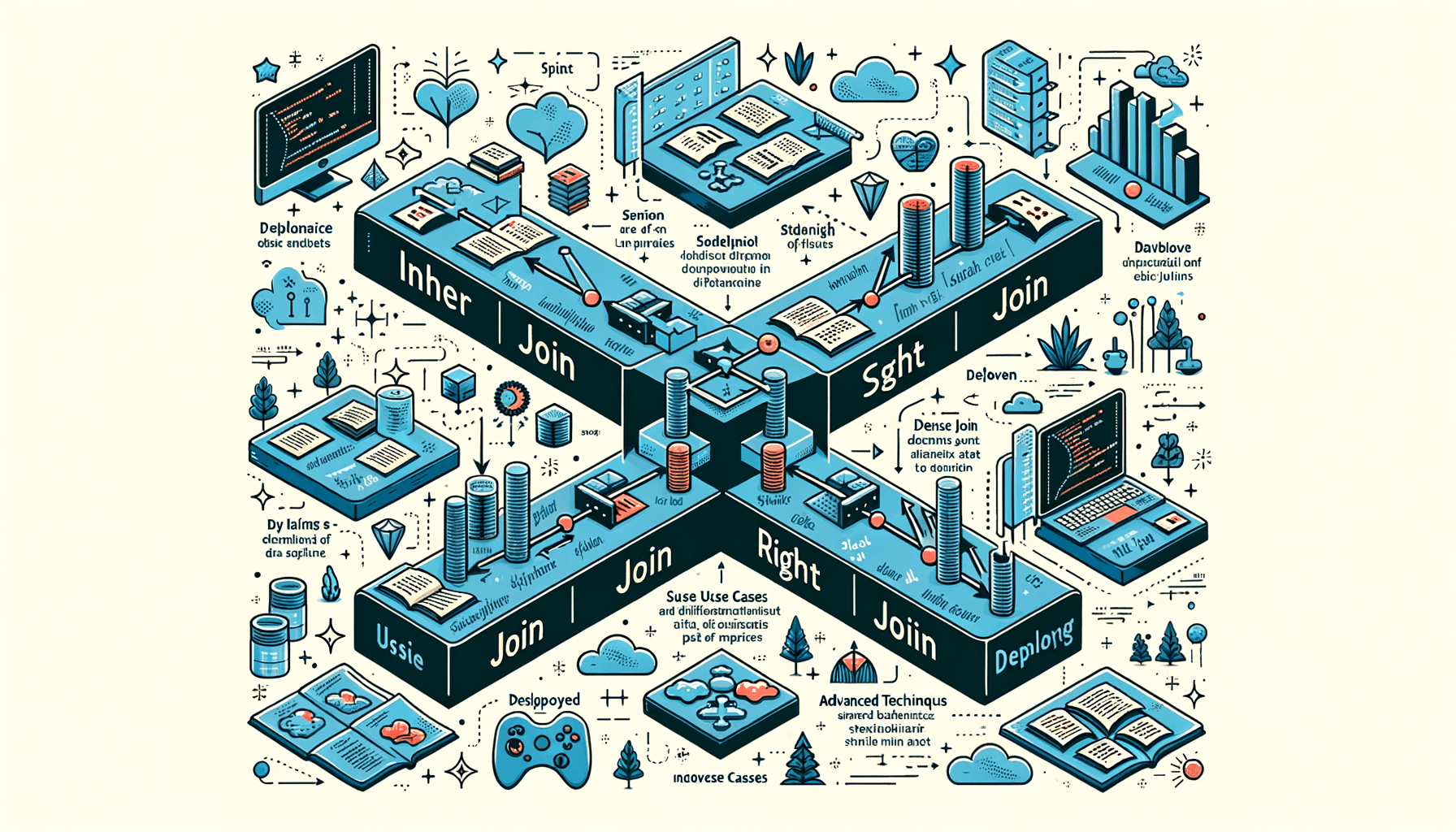A big variety of articles and resources

The Essential Skills Every SQL Developer Should Master
 Sia Author and Instructor
Learn SQL
Sia Author and Instructor
Learn SQL
18 minute read
In today's tech world, knowing SQL is super important for anyone who wants to work with data. SQL, or Structured Query Language, helps you manage and analyze data in databases. This article will explore the key skills every SQL developer should learn to be successful in their career. Whether you're just starting or looking to sharpen your skills, these essential abilities will set you up for success in the field of data management.
Key Takeaways
- Understanding how databases work is crucial for SQL developers.
- Being able to write clear and efficient SQL queries is a must.
- Advanced techniques like joins and window functions enhance data analysis.
- Optimizing database performance can significantly improve application speed.
- Data security and integrity are essential for protecting sensitive information.
Fundamental Database Concepts
Understanding Relational Databases
In my journey as a SQL developer, I have come to appreciate the importance of relational databases. These databases store data in tables, which makes it easy to organize and retrieve information. Each table consists of rows and columns, where rows represent individual records and columns represent the attributes of those records. Understanding how these tables relate to one another is crucial for effective data management.
Normalization and Denormalization
Normalization is a process I often use to reduce data redundancy and improve data integrity. By organizing data into multiple related tables, I can ensure that each piece of information is stored only once. However, there are times when I choose to denormalize data for performance reasons, especially in read-heavy applications. This means combining tables to reduce the number of joins needed during queries.
Database Schema Design
When designing a database schema, I focus on creating a clear structure that supports the needs of the application. A well-designed schema includes defining tables, relationships, and constraints. Here’s a simple overview of the steps I follow:
- Identify the entities (tables) needed.
- Define the attributes (columns) for each entity.
- Establish relationships between entities.
- Set constraints to maintain data integrity.
A well-thought-out database schema is the backbone of any successful database application. It not only improves performance but also enhances maintainability.
Proficient SQL Query Writing
In my journey as an SQL developer, I have learned that writing effective SQL queries is crucial for data retrieval and manipulation. Mastering this skill not only enhances my ability to work with databases but also improves the overall efficiency of data operations.
Crafting Basic Queries
To start, I focus on crafting basic queries using the SELECT statement. This allows me to retrieve data from one or more tables. Here are the key components I consider:
- SELECT: Specifies the columns I want to retrieve.
- FROM: Indicates the table from which to pull the data.
- WHERE: Filters the results based on specific conditions.
For example:
SELECT name, age FROM users WHERE age > 18;
Utilizing Aggregate Functions
Next, I utilize aggregate functions to perform calculations on my data. Common functions include:
- COUNT(): Counts the number of rows.
- SUM(): Adds up values in a numeric column.
- AVG(): Calculates the average of a numeric column.
These functions help me summarize data effectively. For instance:
SELECT COUNT(*) FROM orders WHERE status = 'completed';
Implementing Subqueries
Finally, I often implement subqueries to nest one query within another. This technique allows me to perform more complex data retrieval. For example:
SELECT name FROM users WHERE id IN (SELECT user_id FROM orders WHERE total > 100);
By mastering these fundamental aspects of SQL query writing, I can efficiently extract and manipulate data, which is essential for any SQL developer.
Advanced SQL Techniques
In my journey as an SQL developer, I have found that mastering advanced SQL techniques is crucial for effective database management. These skills not only enhance my ability to write complex queries but also improve the overall performance of the databases I work with.
Mastering Joins and Unions
Joins and unions are fundamental in combining data from multiple tables. Understanding how to use INNER JOIN, LEFT JOIN, and RIGHT JOIN allows me to retrieve related data efficiently. Here’s a quick overview:
| Join Type | Description |
|---|---|
| INNER JOIN | Returns records with matching values in both tables |
| LEFT JOIN | Returns all records from the left table and matched records from the right table |
| RIGHT JOIN | Returns all records from the right table and matched records from the left table |
Working with Window Functions
Window functions are powerful tools that enable me to perform calculations across a set of table rows related to the current row. This is particularly useful for tasks like running totals or moving averages. For example, using the ROW_NUMBER() function helps me assign a unique number to each row within a partition of a result set.
Dynamic SQL and Stored Procedures
Dynamic SQL allows me to build SQL statements dynamically at runtime, which is essential for creating flexible applications. Stored procedures, on the other hand, are precompiled SQL statements that can be executed repeatedly. They help in reducing code duplication and improving performance. Using stored procedures can significantly enhance the maintainability of my SQL code.
Mastering these advanced techniques not only boosts my efficiency but also empowers me to tackle complex data challenges effectively.
By focusing on these advanced SQL techniques, I can ensure that I am well-equipped to handle the demands of modern database environments, ultimately leading to better data management and analysis.
Data Manipulation and Transformation
In the realm of SQL development, mastering data manipulation and transformation is crucial. This skill set allows me to effectively manage and modify data within databases. Understanding how to insert, update, and delete data is fundamental to maintaining accurate and relevant information.
Inserting, Updating, and Deleting Data
When working with databases, I often need to perform three main operations:
- Inserting new records into tables.
- Updating existing records to reflect changes.
- Deleting records that are no longer needed.
These operations are essential for keeping the database current and useful. For example, I might use the following SQL commands:
-- Inserting a new record INSERT INTO employees (name, position) VALUES ('John Doe', 'Developer');
-- Updating an existing record UPDATE employees SET position = 'Senior Developer' WHERE name = 'John Doe';
-- Deleting a record DELETE FROM employees WHERE name = 'John Doe';
Using Common Table Expressions
Common Table Expressions (CTEs) are powerful tools that I use to simplify complex queries. They allow me to create temporary result sets that can be referenced within a SELECT, INSERT, UPDATE, or DELETE statement. This makes my SQL code cleaner and easier to understand.
Data Filtering Techniques
Filtering data is another important aspect of data manipulation. I often use the WHERE clause to specify conditions that must be met for records to be included in the results. For instance, I might want to retrieve only those employees who are developers:
SELECT * FROM employees WHERE position = 'Developer';
In my experience, mastering these data manipulation techniques not only enhances my efficiency but also drives business insights.
By focusing on these essential skills, I can ensure that the data I work with is accurate, relevant, and ready for analysis. This foundation is vital for any SQL developer aiming to excel in their field.
Database Performance Optimization
In my experience as a SQL developer, optimizing database performance is crucial for ensuring that applications run smoothly and efficiently. Effective performance optimization can significantly enhance the speed and responsiveness of database queries. Here are some key areas I focus on:
Indexing Strategies
- Understanding Indexes: Indexes are like a book's index; they help the database find data faster. I always ensure that the right indexes are in place to speed up query performance.
- Types of Indexes: I utilize various types of indexes, such as unique, composite, and full-text indexes, depending on the query requirements.
Query Execution Plans
- Analyzing Execution Plans: I regularly review query execution plans to identify bottlenecks. This helps me understand how the database engine processes queries and where improvements can be made.
- Cost-Based Optimization: By examining the cost estimates in execution plans, I can make informed decisions about rewriting queries or adding indexes.
Database Tuning Techniques
- Configuration Settings: I adjust database configuration settings to optimize performance based on workload.
- Regular Maintenance: Performing regular maintenance tasks, such as updating statistics and rebuilding indexes, is essential for keeping the database running efficiently.
- Monitoring Tools: I use monitoring tools to track performance metrics and identify areas for improvement.
In my journey as a SQL developer, I have learned that regular monitoring and analysis of query execution plans are essential practices for maintaining optimal database performance.
By focusing on these areas, I can ensure that the databases I manage are not only functional but also optimized for performance, leading to better user experiences and more efficient data handling.
Data Security and Integrity
In today's digital world, ensuring data security and integrity is crucial for any SQL developer. I believe that protecting sensitive information is not just a technical requirement but a fundamental responsibility.
Implementing Access Controls
To safeguard data, I focus on implementing strict access controls. This involves:
- Defining user roles and permissions
- Regularly reviewing access logs
- Enforcing the principle of least privilege
Data Encryption Practices
Data encryption is another key aspect of security. I utilize encryption techniques to protect data both at rest and in transit. This ensures that even if data is intercepted, it remains unreadable without the proper decryption keys.
Backup and Recovery Strategies
Having a solid backup and recovery plan is essential. I regularly schedule backups and test recovery procedures to ensure that data can be restored quickly in case of a breach or data loss. This proactive approach minimizes downtime and data loss.
In my experience, maintaining data reliability and compliance with data protection regulations is vital for building trust with users and stakeholders.
By mastering these practices, I can contribute to a secure and reliable database environment, which is essential for any organization.
Understanding Transaction Management
In the world of databases, managing transactions is crucial for ensuring data integrity and consistency. Transactions are sequences of operations performed as a single logical unit of work. This means that either all operations in a transaction are completed successfully, or none are applied at all. This is essential for maintaining the accuracy of data.
ACID Properties
To understand transactions better, we need to look at the ACID properties:
- Atomicity: Ensures that all operations in a transaction are completed; if one fails, the entire transaction fails.
- Consistency: Guarantees that a transaction will bring the database from one valid state to another.
- Isolation: Ensures that transactions occur independently without interference.
- Durability: Once a transaction is committed, it remains so, even in the event of a system failure.
Transaction Isolation Levels
There are different isolation levels that control how transaction integrity is visible to other transactions. Here’s a brief overview:
| Isolation Level | Description |
|---|---|
| Read Uncommitted | Allows dirty reads; transactions can see uncommitted changes. |
| Read Committed | Prevents dirty reads; only committed changes are visible. |
| Repeatable Read | Ensures that if a row is read twice in the same transaction, it will return the same values. |
| Serializable | The highest level; transactions are completely isolated from one another. |
Handling Concurrency Control
Concurrency control is essential in a multi-user environment. Here are some techniques:
- Locking: Prevents other transactions from accessing the same data until the lock is released.
- Timestamping: Assigns a unique timestamp to each transaction to determine the order of operations.
- Optimistic Concurrency Control: Assumes that multiple transactions can complete without affecting each other, checking for conflicts before committing.
Understanding transaction management is vital for any SQL developer. It not only helps in maintaining data integrity but also enhances the overall performance of database operations.
In conclusion, mastering transaction management is a key skill for any SQL developer. It ensures that our data remains reliable and consistent, which is essential for any application that relies on a database. By focusing on the ACID properties, isolation levels, and concurrency control, I can ensure that my database transactions are handled effectively, leading to better data management and application performance.
Additionally, mastering these skills is crucial for excelling in data-related roles and tackling SQL questions confidently.
Data Analysis and Reporting Skills
In my journey as an SQL developer, I have come to realize that data analysis and reporting skills are crucial for making informed decisions. These skills allow me to extract meaningful insights from data, which can significantly impact business strategies.
Creating Views and Materialized Views
Creating views is a fundamental skill that helps in simplifying complex queries. A view is essentially a virtual table that presents data in a specific format. Materialized views, on the other hand, store the result of a query physically, which can improve performance for frequently accessed data. Here’s a simple comparison:
| Feature | Views | Materialized Views |
|---|---|---|
| Storage | No | Yes |
| Performance | Slower for complex queries | Faster for repeated queries |
| Update Frequency | Real-time | Periodic |
Generating Reports with SQL
Generating reports is another essential skill. I often use SQL to create reports that summarize data for stakeholders. This involves using aggregate functions like SUM, COUNT, and AVG to provide insights. Here’s a basic example of how I might summarize sales data:
SELECT product_id, SUM(sales) AS total_sales FROM sales_data GROUP BY product_id;
Data Visualization Techniques
While SQL is powerful for data manipulation, I also find it beneficial to visualize data. Using tools like Tableau or Power BI, I can create visual representations of the data I analyze. This helps in conveying insights more effectively to non-technical stakeholders.
In my experience, combining SQL skills with data visualization techniques enhances the ability to communicate findings clearly and effectively.
By mastering these skills, I can ensure that the data I work with is not only accurate but also presented in a way that drives decision-making. The integration of SQL in data analysis is essential, as it allows for efficient data manipulation and insight extraction, making it a vital tool in my toolkit.
Collaboration and Version Control
In the world of SQL development, collaboration and version control are essential skills that I have found to be invaluable. Working with a team means that we need to share our code and ideas effectively. Here are some key points I have learned:
Using Git for Database Projects
- Git is a powerful tool for version control. It allows me to track changes in my SQL scripts and collaborate with others without losing any work.
- I can create branches for new features or fixes, which helps keep the main codebase stable.
Collaborative Database Development
- When working with others, I make sure to communicate clearly about changes. This includes discussing any new features or updates to the database schema.
- Regular meetings help us stay aligned and address any issues quickly.
Change Management Practices
- I have learned to document changes thoroughly. This includes writing clear commit messages and maintaining a changelog.
- Using tools like GitHub or GitLab not only helps in version control but also provides a platform for code reviews, which improves the overall quality of our work.
In my experience, effective collaboration and version control practices lead to smoother project workflows and better outcomes.
By mastering these skills, I can ensure that my contributions to SQL projects are organized, efficient, and easily integrated with the work of my teammates. This ultimately enhances our productivity and the quality of our database solutions.
Real-World Problem Solving
In my journey as an SQL developer, I have learned that solving real-world problems is crucial for mastering SQL. This section focuses on practical skills that can be applied in everyday scenarios.
Case Studies in SQL Development
I often analyze case studies to understand how SQL is used in various industries. These studies provide insights into how different companies tackle their data challenges. For example, a retail company might use SQL to analyze sales data and improve inventory management. This real-world application helps me see the value of SQL in decision-making processes.
Hands-On Project Experience
Engaging in hands-on projects is essential. I recommend starting with small projects that interest you. Here are some ideas:
- Create a database for a personal project, like a book collection.
- Analyze a dataset from a public source, such as government statistics.
- Collaborate with peers on a group project to build a database application.
These projects not only enhance my skills but also make learning more enjoyable.
Industry Best Practices
Learning from industry best practices is vital. I focus on:
- Understanding how to write efficient queries.
- Learning about data normalization and its importance.
- Keeping up with the latest SQL trends and tools.
By following these practices, I can ensure that my SQL skills remain relevant and effective.
Engaging in SQL challenges and competitions fosters learning and growth. Working on real-world SQL projects, aligned with personal interests, enhances motivation and practical experience. Collaboration in team projects improves skills in database design and query optimization. Applying SQL in professional settings and exploring advanced topics like subqueries and joins further develops proficiency, bridging theoretical knowledge with practical application.
Continuous Learning and Adaptation
In the ever-evolving field of SQL development, continuous learning is crucial for success. As I navigate my career, I find that staying updated with the latest trends and technologies is essential. Here are some key areas I focus on:
Staying Updated with SQL Trends
- I regularly read blogs and articles to keep up with new features and best practices.
- Participating in webinars helps me learn from experts and gain insights into industry changes.
- Following influential figures in the SQL community on social media keeps me informed.
Participating in SQL Communities
- Joining online forums and discussion groups allows me to share knowledge and ask questions.
- Attending local meetups or conferences provides networking opportunities and exposure to new ideas.
- Contributing to open-source projects enhances my skills and connects me with other developers.
Pursuing Advanced Certifications
- I consider certifications as a way to validate my skills and knowledge.
- Enrolling in specialized courses helps me deepen my understanding of complex topics.
- I often look for free resources that offer valuable learning strategies, such as community challenges and mentorship opportunities.
Continuous learning is not just about acquiring new skills; it's about adapting to the changing landscape of technology and ensuring that I remain a valuable asset in my field.
By focusing on these areas, I can effectively adapt to the demands of the SQL development world and enhance my career prospects.
In today's fast-paced world, learning never stops. To keep up, you need to adapt and grow your skills continuously. Our website offers a variety of courses that can help you stay ahead in your career. Don't wait—visit us now to start your journey toward success!
Conclusion
In conclusion, mastering SQL is crucial for anyone looking to excel in data management and analysis. The skills discussed in this article, such as understanding database structures, writing effective queries, and ensuring data integrity, are essential for success in various tech roles. By developing these abilities, aspiring SQL developers can enhance their career prospects and contribute significantly to their organizations. As the demand for data-driven decision-making continues to grow, the importance of SQL expertise will only increase, making it a valuable asset in the tech industry.
Frequently Asked Questions
What skills do I need to start learning SQL?
To begin learning SQL, you should have basic computer skills and a desire to work with data. Understanding how databases work is also helpful.
Is SQL difficult to learn?
SQL is not very hard to learn, especially if you take it step by step. With practice, you can become good at it.
What can I do with SQL skills?
With SQL skills, you can work in jobs like data analyst, database administrator, or software developer. It helps you manage and analyze data.
Do I need a degree to work with SQL?
While having a degree in computer science or a related field can help, many people get jobs in SQL without a degree, especially if they have good skills.
How long does it take to learn SQL?
The time it takes to learn SQL varies. Some people can learn the basics in a few weeks, while becoming an expert may take several months.
Can I learn SQL online?
Yes, there are many online courses and tutorials that can help you learn SQL at your own pace.
What is the difference between SQL and MySQL?
SQL is a language used to communicate with databases, while MySQL is a specific database management system that uses SQL.
Are there jobs for SQL developers?
Yes, there are many job opportunities for SQL developers in various industries, as data management is crucial for businesses.







